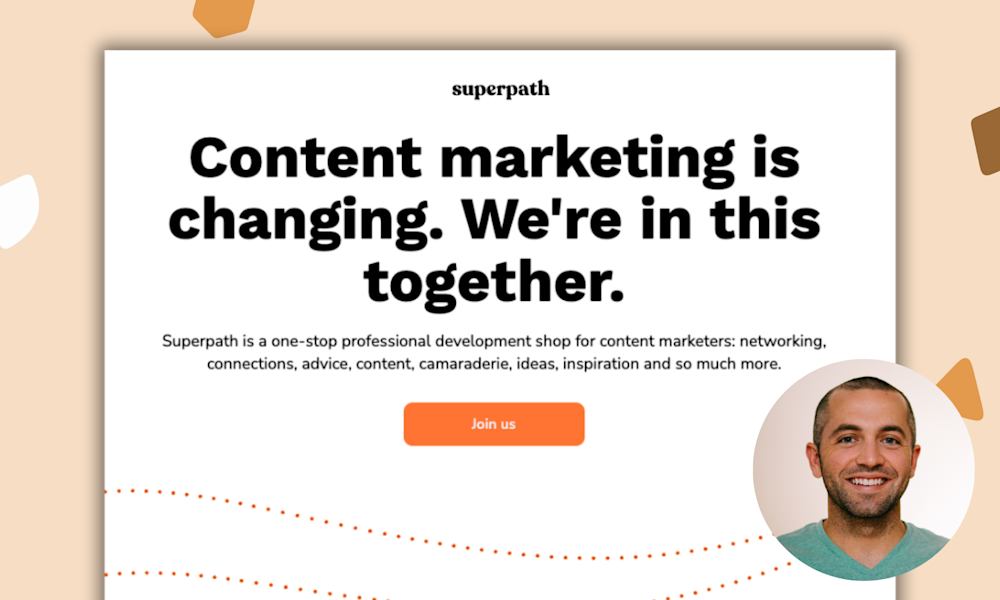When Podia creator Em Connors launched her first online course, it only took her a few days to hit five figures in sales. Forty-five students enrolled within a week, and she knew she was onto something special. But her success was no accident.
Em has a knack for social media. As an online course creator and founder of The Creative Bodega, she helps entrepreneurs use Canva and content batching to teach their passions, connect with their followers, and make more sales.
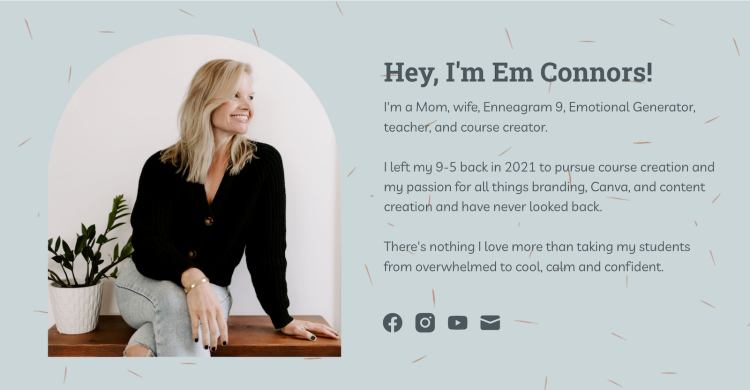
Today, Em shares her framework for launching profitable courses with ease. Here's how she built a loyal audience, structured her programs, and used audience feedback to create meaningful products — and how you can do the same.
From social media mentor to online course creator
Before she started The Creative Bodega, Em and her husband ran a gym business. To promote their programs, a mentor challenged them to post on Instagram every day for 30 days.
By day five, Em was exhausted and out of ideas. She heard about Canva and knew she needed a strategy to keep coming up with content, so she gave the free graphic design tool a try.
"I got on Canva and made it my mission to create a system, so I wasn't scrambling to figure out what to post. I decided to have a theme each day. When you know that one day you’ll post an inspirational quote and the next day you'll post an educational reel, the decision fatigue gets eliminated," Em remembers.
With a theme-based content strategy and a bank of beautiful Canva images, Em started posting daily. She shared a video every Thursday and frequently spoke to the camera to connect with her audience. Her new system made posting a breeze, and her Instagram account grew.
People noticed Em's social media prowess, and she was hired as a business and marketing mentor for other gym owners.
"I loved teaching, I loved helping, and I noticed that when my clients wanted to talk about Canva or social media, that lit me up. I would get off that call and feel so inspired," Em reflects.
But as her calendar filled with clients, Em was exhausted from hours of live mentoring. She didn't have much time to spend with her family, and she felt limited trading hours for dollars. She realized that creating an online course could help her scale her teaching without increasing her workload.
Eager to share her love for Canva and help other creators overcome social media burnout, Em's Canva Crash Course was born.
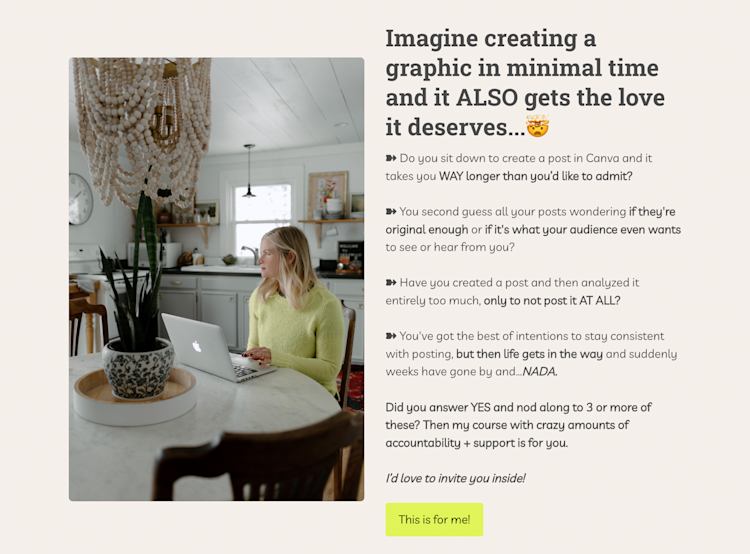
She developed a launch strategy and opened the program up to her audience.
Forty-five students enrolled in just a few days.
Months later, she used the same tactics to promote her follow-up course, Batch Like a Boss. Again, her audience enthusiastically embraced her offer.
Em had cracked the course-launching code.
Inside Em's course launch playbook
Em built trust with her audience by providing helpful, high-value content. She used a live cohort format to generate excitement among followers, and student feedback was her north star when making decisions. To prevent headaches and endless troubleshooting, Em also built her business with trustworthy, user-friendly software.
Let's take a closer look.
Build relationships by consistently providing value
As soon as she decided to make a course about Canva, Em made a new Instagram account for her business. She spent the next six months leading up to her launch sharing social media tips and Canva strategies, without asking her followers for anything in return.
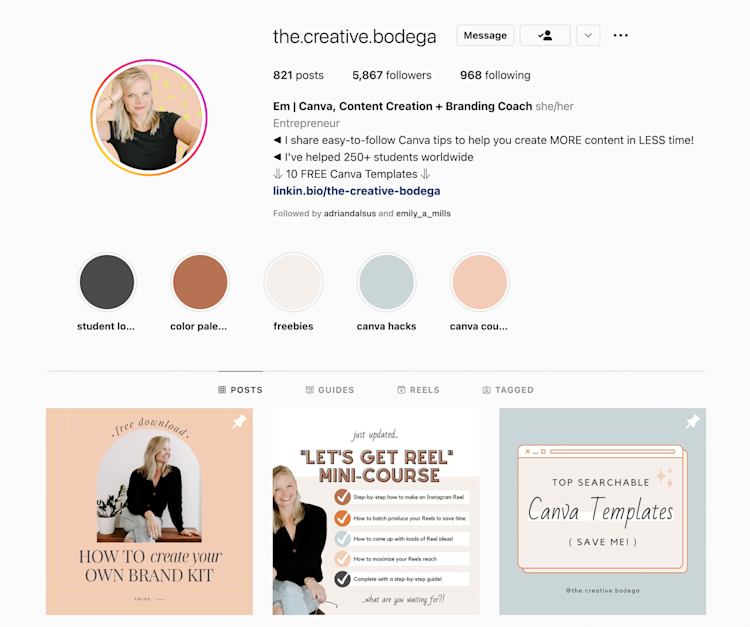
Every day, she posted educational, inspirational, or entertaining content, and her audience grew. "I was there to help," Em elaborates, "I wanted them to think of me when they think of Canva."
Em uses Instagram as her primary platform, but you can pick any social media channel that resonates with you. "Pick one platform and go all in on it," she advises. "Don’t spread yourself too thin, and get to know it inside and out."
Once you've selected a platform, consistency is key.
“Every day, [I show up](https://www.instagram.com/p/Ce3fcBksoEC/). I show my face all the time, so my followers know who I am. They hear me speaking and get a glimpse of what it would be like to take one of my courses.”
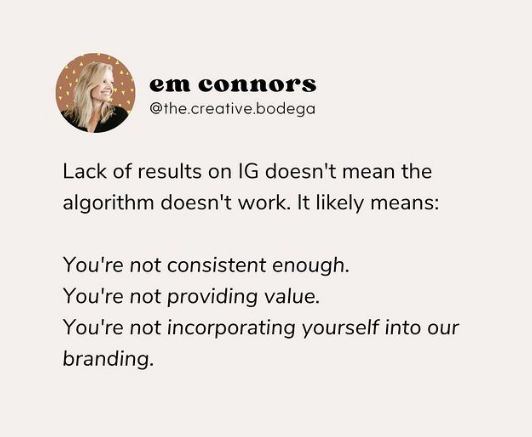
Social media is great for building relationships with potential clients. "Every DM, every comment, I never let anything go unanswered," Em says. "People ask me questions all the time. I love teaching and helping. Whether you’re a student or a follower, you will hear back from me."
Em also serves her audience through free workshops. These sessions allow Em to grow her email list and share advice in a live learning environment, giving potential students a free sample of her teaching style.
One thing that makes Em’s workshops stand out is that she doesn’t end with a sales pitch. "People told me they bought my course because I didn’t sell to them at the end of my workshops, and I was only focused on helping them out. That feels awesome."
Em's advice:
“Focus on becoming an expert in your niche without expecting anything in return. When I finally did have something to offer, my audience was all ears because I had consistently provided value.”
Do a live launch to build excitement
While Em offers a variety of digital products, live launch cohort courses — group programs with a brief enrollment period and a specific start and end date — are the most exciting for her and her audience.
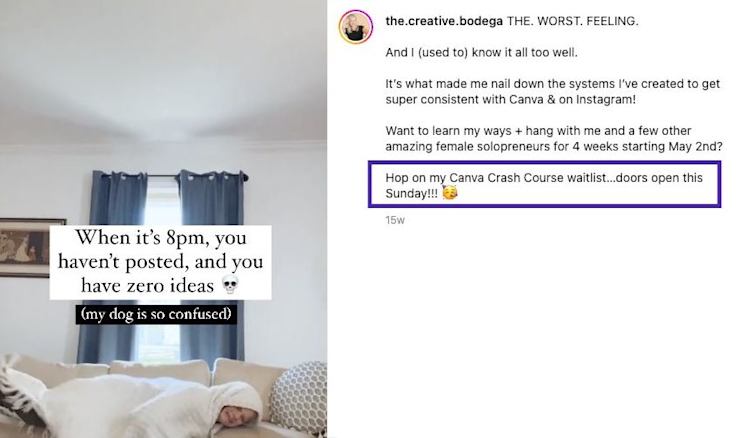
"About a month before launch, I create a waitlist," Em shares. "On Instagram, I start hyping the course up, showing people behind the scenes, and talking about launch emails. I share a link so followers can join my waitlist and get a discount if they sign up during the presale."
With a waitlist, you can talk to interested customers without overwhelming your whole email list. Em recommends incentivizing people to join your waitlist by offering discounts and special bonuses.
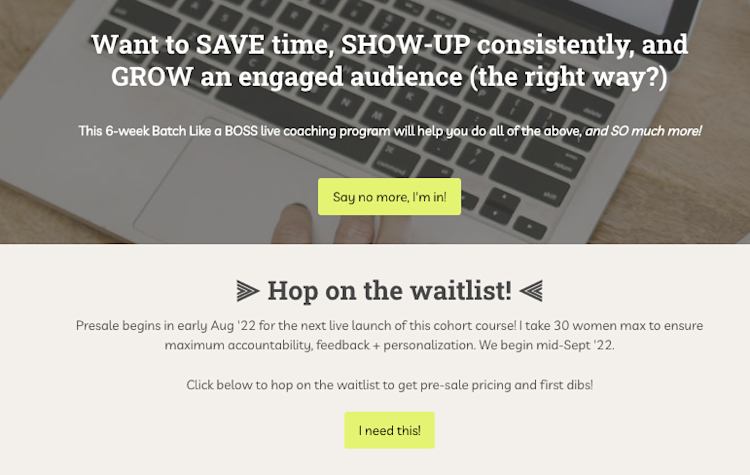
When it's time to launch, Em only keeps enrollment open for five days. "For me, a long cart open is like a kiss of death," she explains. "You lose energy and momentum, and your followers get tired of hearing about it."
During the open cart period, Em posts on Instagram and reaches out to her email subscribers. "I'll email once a day for five days. On the last day, I email twice, once in the morning and once at night for their last chance."
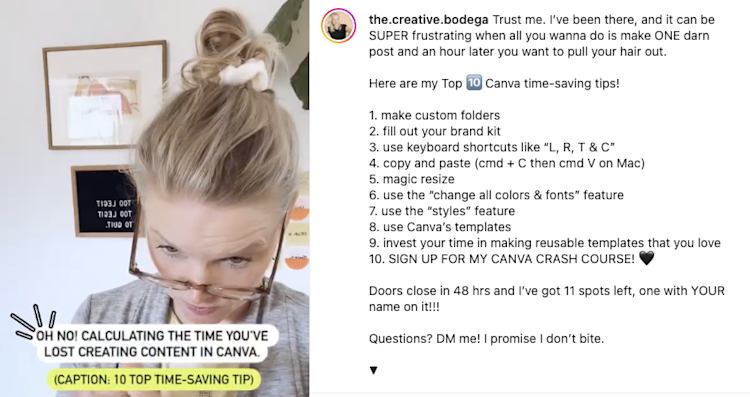
After months of serving her audience and five busy launch days, the cart closes. Class is in session.
Em uses Podia to structure her programs two different ways. In her Canva Crash Course, video sessions are pre-recorded and there are weekly Zoom calls for questions. In Batch Like a Boss, Em teaches live for an hour every week. After the session, she uploads the recording and supplementary materials into Podia for anyone who couldn’t attend.
Both of Em's courses have a community component. Community topics are organized by week, and students can share their assignments for feedback. In both courses, students get plenty of access to Em and her expertise.
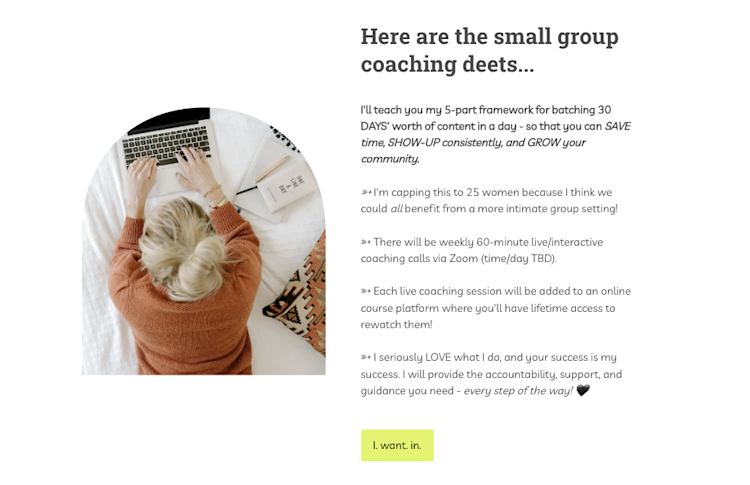
"I love the live cohort aspect because it holds people accountable. People are more involved, and they're more excited." The excitement is contagious; for Em, there's nothing better than helping students reach their goals.
Use student feedback to make business decisions
Regularly communicating with followers has been essential to Em’s creator journey. She uses audience feedback to generate content ideas and shape her courses.
Before launching her Canva course, Em reached out to eight creative entrepreneurs to learn about their pain points using Canva. They shared things she hadn’t thought of, and those interviews informed some of her students' favorite course modules.
She also uses social media to learn from her followers. "I'm always talking to my audience. I love using stories on Instagram. Your stories are for your people, the ones who are really paying attention," Em observes.
Em uses Instagram to ask things like:
-
"What is your biggest struggle with regular posting?"
-
"What is your biggest challenge with Canva templates?"
-
"What do you need help with today?"
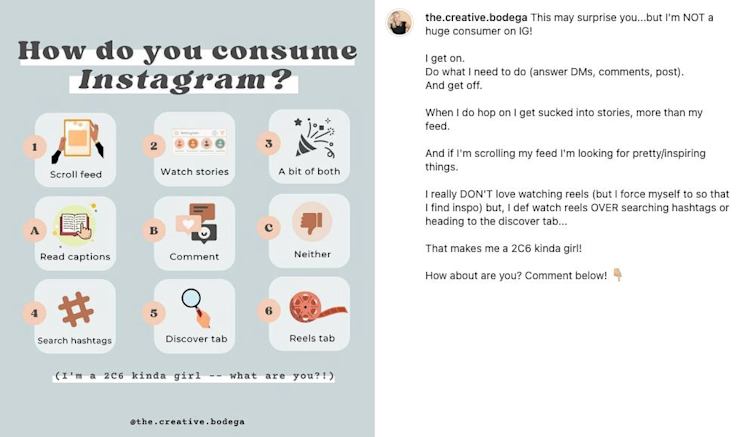
When audience members shared that they struggled with consistency and mapping out post ideas, Em used their input as inspiration for her Batch Like a Boss course. Because the program was a direct response to a topic her audience requested, it was an easy sell.
Creating resources that your customers want or need is key to succeeding as a creator. Em says,
"I think that's where people go wrong. They just make a course about something they're excited and passionate about, but they haven't talked to people to find out if there's a need for that topic."
Regular communication with your audience keeps their needs at the forefront and lets you make the best possible products and content.
Use tools you can trust
The final piece of the puzzle is finding the right technology to support your work.
When Em first released her Canva course, she was using WordPress and a course plugin. On the first day of class, disaster struck. None of her students could log in due to a technical issue, and the plugin company wasn’t responding to Em's help requests.
"Talk about anxiety! I don’t think my heart rate has ever been as high, and there was absolutely no one to talk to," she recalls.
In need of a solution, Em frantically researched alternatives. This led her to Podia. "I hopped on a chat with someone from Podia to tell them what was going on," she remembers. "They told me that we could import my students, and they were so nice. They made it easy."
"I decided to do it, and in 24 hours, I moved my entire course over into Podia."
"I moved every Vimeo link. I recreated every lesson. And then 24 hours after starting my course, I emailed everybody to apologize and give them their new logins."
Em has been with Podia ever since, and it’s been smooth sailing. Not having to worry about technical issues frees Em up to create even more meaningful programs for her audience.
The moral of the story: use technology that you can trust. You have enough on your plate as a creator, and choosing software that’s easy, reliable, and creator-friendly allows you to focus on what you do best.
Keeping up with Em Connors
Em's course launch formula is simple and effective:
-
Consistently provide value to your audience long before you ask them to buy from you.
-
Build your email list with free workshops or resources without an upsell at the end.
-
Run live cohort programs to increase excitement and accountability.
-
Use a waitlist to communicate with your most interested followers.
-
Ask for audience feedback so your course addresses real pain points. Continue asking for input as you update your products and create new content.
-
Use dependable technology so you can spend your time teaching, not troubleshooting.
Today, Em continues to create game-changing programs for her followers.
With helping others at the core of her creator business, we know there's no limit to what Em will achieve.
If you want to follow in Em's footsteps, grab your free 30-day trial of Podia today. You can create a website, build your email list, and release your first digital download. Happy launching!
